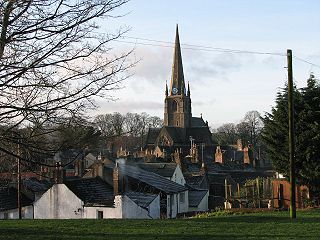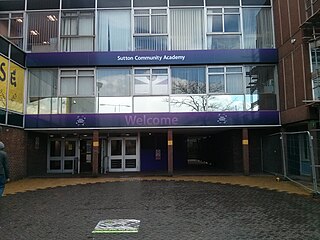Related Research Articles

Cumbria is a ceremonial county in North West England. It borders the Scottish council areas of Dumfries and Galloway and Scottish Borders to the north, Northumberland and County Durham to the east, North Yorkshire to the south-east, Lancashire to the south, and the Irish Sea to the west. Its largest settlement is the city of Carlisle.

Workington is a coastal town and civil parish at the mouth of the River Derwent on the west coast in Cumberland, Cumbria, England. At the 2011 census it had a population of 25,207.

Cockermouth is a market town and civil parish in the Cumberland unitary area of Cumbria, England, so named because it is at the confluence of the River Cocker as it flows into the River Derwent. The mid-2010 census estimates state that Cockermouth has a population of 8,204, increasing to 8,761 at the 2011 Census.

Aspatria is a town and civil parish in Cumberland, Cumbria, England. The town rests on the north side of the Ellen Valley, overlooking a panoramic view of the countryside, with Skiddaw to the South and the Solway Firth to the North. Its developments are aligned approximately east–west along the A596 Carlisle to Workington road and these extend to approximately 2 miles (3.2 km) in length. It lies about 8 miles (13 km) northeast of Maryport, a similar distance to the Southwest of Wigton, about 9 miles (14 km) north of Cockermouth and 5 miles (8.0 km) from the coast and Allonby. It comprises the townships of Aspatria and Brayton, Hayton and Mealo, and Oughterside and Allerby, the united area being 8,345 acres (3,377 ha); while the town takes up an area of 1,600 acres (647 ha). In earlier days a Roman road leading from "Old Carlisle" to Ellenborough passed through the hamlet.
Ark Alexandra, previously known as Hastings Grammar School, William Parker School, William Parker Sports College, and later as Ark William Parker is a secondary school in Hastings, East Sussex in the United Kingdom. It was the only male single-sex secondary school in East Sussex and is now a co-educational Academy spread over two sites after Ark Helenswood Academy merged with Ark William Parker on 1 September 2019.

Seaton is a large village and civil parish in Cumbria, England. Historically part of Cumberland, near the Lake District National Park in England. It is home to around 5,000 people and is one of the largest villages in England. The population of the parish was measured in the 2011 Census as 5,022. Historically a part of Cumberland, it is situated on the north side of the River Derwent, across from the town of Workington, and close to the smaller village of Camerton. Seaton forms part of the Borough of Allerdale.
Secondary technical schools, referred to colloquially as secondary techs or simply techs, were a type of secondary school in England and Wales that existed in the mid-20th century under the Tripartite System of education. Few were built; their main interest is theoretical.

Newham Sixth Form College (NewVIc) is a sixth form college located in the East London borough of Newham. Situated on a single site in Plaistow, the college was established in 1992 to provide for students in Newham and neighbouring boroughs who opt to stay in education beyond GCSE O-levels. It is designed for students ages 16 to 19 and its curriculum includes A-levels as well as specialist pathway, levels 2 and 3 vocational, foundation level and ESOL programmes. There are currently about 2,500 students at the college.

Jesmond Park Academy is a coeducational secondary school and sixth form located in Heaton, Newcastle upon Tyne, England.

Sutton Community Academy is a coeducational secondary school and sixth form with academy status, located in Sutton-in-Ashfield, Nottinghamshire, England.
St Joseph's Catholic Academy is a coeducational Roman Catholic secondary school with academy status, located in Hebburn, South Tyneside, England.

Richmond Park Academy is a secondary school with an academy status in the London Borough of Richmond upon Thames. The school is part of the Academies Enterprise Trust academy chain.

Lakes College is a further education institute located at Lillyhall, Cumberland, England, between the towns of Workington and Whitehaven.
Richmond and Hillcroft Adult Community College is a further education college located in Richmond and Surbiton in Greater London. It was established in 2017 by a merger between Richmond Adult Community College and the specialist Hillcroft College.

Furness Academy is a secondary school in Barrow-in-Furness, England. It is the fourth academy to have been formed in the county of Cumbria after the closure of Alfred Barrow School, Parkview Community College of Technology and Thorncliffe School in 2009. Having utilised numerous buildings of the former Parkview and Thorncliffe Schools since 2009, a single £22 million building opened in the Parkside area of the town in September 2013.
Education in Kingston upon Hull is governed by the unitary authority of Kingston upon Hull.
This article details a number of defunct schools that were once located in Sandwell in the West Midlands of England. For details of currently operating schools in Sandwell, please see: List of schools in Sandwell.
Carisbrooke College is a foundation trust-supported secondary school in Carisbrooke on the Isle of Wight, formerly Carisbrooke High School. Sixth form students are based at the Island Innovation sixth form Campus, in Newport, a shared sixth form with Medina College.
Plaistow County Grammar School, also known as "Plaistow Grammar" or "PGS", was a local authority mixed gender Grammar school established in 1945 and located on Prince Regent Lane (A112) in Plaistow, in the County Borough of West Ham and then the London Borough of Newham in east London. It was disestablished in 1972 upon its merging to create a Comprehensive school.
Richard Rose Central Academy is a coeducational secondary school and sixth form with academy status. It is located in Carlisle in the English county of Cumbria.
References
- ↑ "Workington County Technical and Secondary School". Nature. Nature Publishing Group. 97 (2428): lxxxii. 11 May 1916. Retrieved 19 February 2024.
- ↑ "Workington County Technical and Secondary School". Discovery. The National Archives. Retrieved 19 February 2024.
- ↑ "Workington: The Cumberland Technical College (formerly part of Workington County Technical and Secondary School)". Discovery. The National Archives. Retrieved 19 February 2024.
54°38′34″N3°33′05″W / 54.6429°N 3.5513°W